[This series is a diary of our experience with raising chickens for our home flock. To see all articles in this series, please visit Home Flock Series.]
Brooder Temperature
As the chicks grow older, then don’t need as much supplementary heat. A good rule of thumb is to start at 90-95°F and reduce their brooder temperature by 5°F each week until you reach 70°F. You can adjust and monitor the temperature with the help of a thermometer, or you can do as we have been doing and watch the behavior of the chicks to determine if the brooder is too warm or too cold in order to make adjustments. (If the chicks avoid the warm area directly beneath the heat lamp, they’re too warm, and if they huddle together, they are too cold.)
With the warmer outdoor weather and the chicks being a week older, we now have the heat lamp suspended about 3 feet above the top of the brooder. On warm days, in the 90s (F), we turn off the heat lamp altogether until the day begins to cool as evening approaches.
Sparring
The chicks are growing well. Some of them have begun sparring. This usually only lasts for a few seconds at a time, and it is difficult to capture a photo of them in action. The photo below is the closest I’ve gotten, and it isn’t fully representative of their action. The camera’s shutter speed is 1/60, so you can see that the chicks’ wings are moving pretty fast.
Wing and Tail Feathers
The chicks’ wing feathers and tail feathers are developing at a different rates among the different breeds. The Araucanas/Americanas have the most fully developed wings, and the Partridge Rocks and Turkens are close behind them, though there is quite a bit of variability among the Turkens. The Araucanas, Partridge Rocks, and Turkens are all beginning to show tail feathers.
The Buff Rocks have the largest body size of all the chicks, but their wing feathers are developing more slowly, and their tail feathers are not yet obvious.
Foraging in the Yard
We brought 16 of the chicks out into the yard today to let them forage. At first, they were rather timid, but now they have become a little more adventurous. The are finding small seeds or insects to eat and nibbling on bits of grass. After foraging for awhile, they sit down or lay down to rest, then after a few minutes they start to forage again.
Feeders
We added a second, larger tray feeder to the brooder because the chicks have been going through the feed quickly (we’ve been replenishing the small feeder several times per day).
Free Rare Chick
We’ve identified which chick is the Exotic Rare Chick, and are fairly sure it is an Americana, based on its pea comb and blue-green leg color, though it is distinctly different from the others both in plumage color and in lacking the prominent feathered tufts on the side of the face. I think it is the most handsome of the bunch.
Photo Gallery
You can click any of the photos thumbnails below to see a larger view.
- Americana
- Americana
- Buff Rock
- Free Rare/Exotic Chick
- Free Rare/Exotic Chick
- Free Rare/Exotic Chick
- Free Rare/Exotic Chick
- Chicks Foraging
- Americana, Turken, and Five Partridge Rocks
- Partridge Rock
- Chicks Sparring
- Turken and Buff Rock Foraging in the Yard

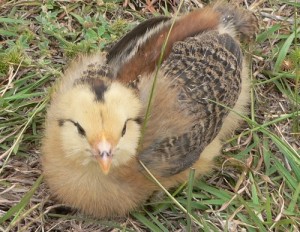
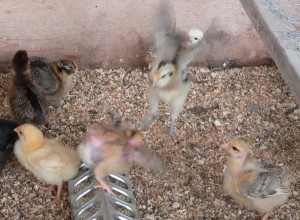
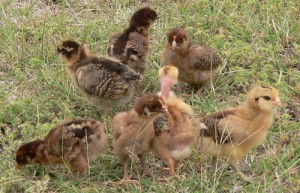
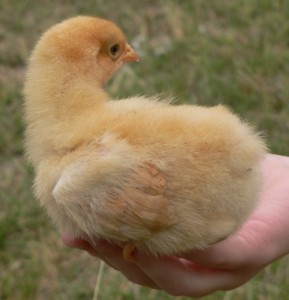
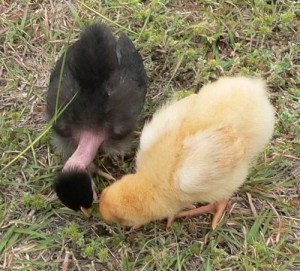
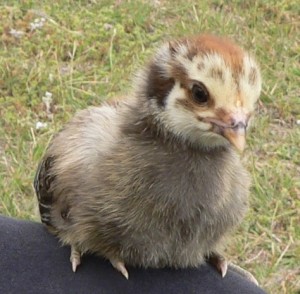
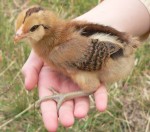

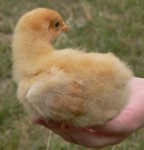
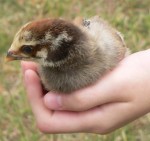
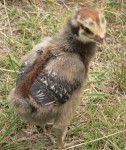
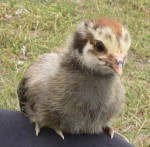
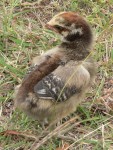
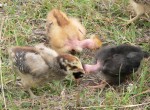

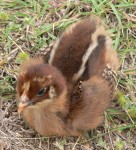

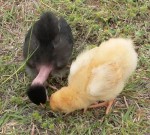


Here in West Texas we are having 100 plus degree heat every day. Nights only get down to about 75 or 80. The 28 chicks I have are 13 days old. I have 2 fans and 2 exaust fans going all the time in their barn area but the temp stays around 100+ during the day. I am watching them closely, but worry about long term problems from the heat. Any suggestions as to what to do.
Thanks,
Sam R
Having the fans running is good, along with anything else you can do to improve ventilation. Some other things you can do are:
– keep cool water in their waterers
– setup a misting system that uses a fine mist of water to lower the temperature
– shade any areas that are exposed to sunlight
– spray water onto the exterior of their housing to cool it down
– make sure they have plenty of room and are not overcrowded
Partridge Rocks are adorable, and I raised 4 of them in 2008, along with 4 each of Leghorns, RI Reds, Araucanas, Barred Rocks, Silver Laced Wyandottes, Red Star, etc. The Partridge and Araucanas were the least prolific layers, and the Leghorns the most. I’m new to reading blogs but thanks for yours. Easy to go to!
I would use Vetericyn. I used it on my roosters eye and there was immediate improvement. It may seem pricey in the beginning, but you pay more for a vet visit. I used it on myself for a really nasty spider bite. They now make it specifically for the eyes and for humans, etc. but I use the original for everything. I know people that raise all types of live stock and they all use it. My lab for the first time in her life developed two huge hot spots on her rump. I can’t tell you how fast this product cleared it up.
I am loving your blog! Please keep adding to it…. I am interested in starting a small flock to harvest a few fresh eggs…. My birthday is next month & I’m hoping my husband will have time off work so we can set up a coop & get the other necessities together. We have been reading up on different things, hoping not to run into too many problems when we jump in to this…..any advice that you can offer, please do. Thanks, can’t wait to read your next post! :)
Thank you, Shelly. I’m glad these articles are helpful to you.
I have baby chicken’s they are about 2 month’s old they are having some kind of eye problem their eye’s are matting up can anyone offer some advise please!!!!!